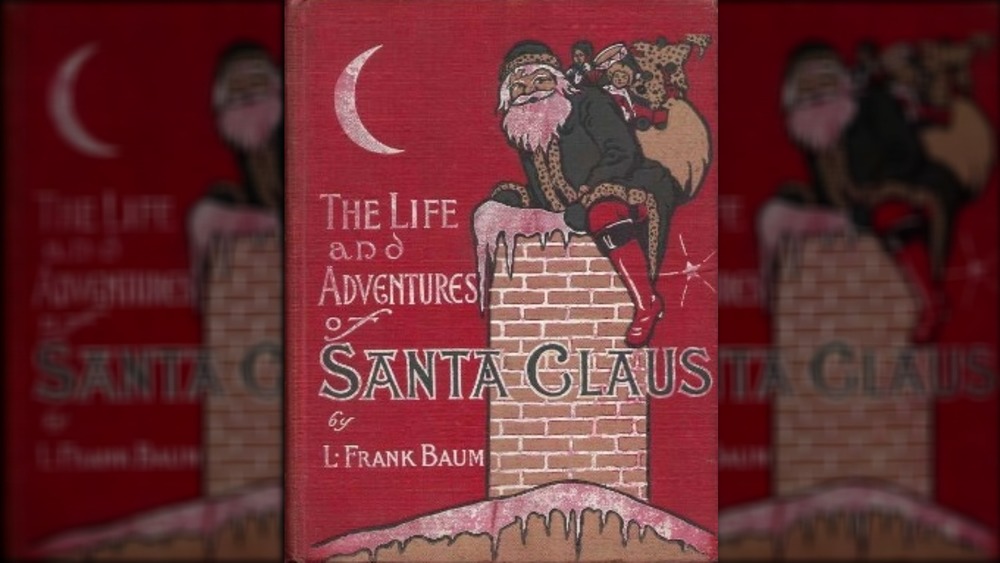The Surprising Connection Between Oz And Santa
We may receive a commission on purchases made from links.
We all know that Santa Claus has supernatural abilities. He can make reindeer fly, travel at super speed, carry limitless toys in one bag, and devour a world of milk and cookies in one night without losing that fantastic form. But have we ever stopped to wonder how Santa became so preternaturally abled? From what source does he derive his bottomless reserve of Christmas cheer?
All of these questions and more can be answered by taking a look into Santa's connection to Oz, the magical land of wizards, witches, flying monkeys, talking lions, and so forth. The Life and Adventures of Santa Claus is a children's book by L. Frank Baum, who is better known as the author of The Wonderful Wizard of Oz. Published in 1902, the former is a fanciful biography of the jolly man that follows his development from his childhood with the Wood Nymphs who raised him to his battles against the evil Awgwas as a grownup, and on into old age, revealing how he became immortal. Although he's not officially from the Wizard of Oz series, Santa is a part of the Oz universe and has made a few appearances in the fantastical land in his day. Let's take a look into Kris Kringle's early days, when he was a man about Oz, long before he was relegated to mall Santa for the rest of eternity.
Santa's adventures before he visited Oz
In L. Frank Baum's book, Santa was raised by Wood Nymphs in the enchanted Forest of Burzee after being found abandoned as a baby. According to their Fandom wiki, the nymphs care for the forest's trees, feast on nuts, celebrate the changing colors in the leaves — you know, forest stuff. Santa was adopted by a nymph named Necile, who named him Claus, which in nymph means "little one." The queen then named him Neclaus, meaning "Necile's little one," per Mission.org. This was Baum's way of linking his Santa Claus legend to the name that actually comes from St. Nicholas.
Santa couldn't stay in the enchanted forest once he grew up, so he moved to the Laughing Valley, where he invented toys. Santa's toys caused all the world's kids to behave themselves, and the beings of pure teleporting evil called Awgwas couldn't be having any of that, so they kidnapped him a couple of times. After he was saved by fairies and beings called Knooks, the Awgwas just stole all the toys, and figured that was that. But Master Woodsman Ak gathered an army of dragons, giants, demons, and Goozzle-Goblins, and put the Awgwas in their place. Later in his life, Santa was given the Mantle of Immortality by the Supreme Master and the rest of the immortals, thus joining them in deathlessness. Aside from introducing a gnome character that would appear in subsequent Oz books, Santa Claus himself would show up in the Oz series a few years later.
Santa Claus made a visit to the land of Oz
Seven years after his adventurous biography of Santa Claus, L. Frank Baum wrote the gift-giver back into his fantastic world, this time making him a character in his 1909 book The Road to Oz. In this one, Santa is a guest at the birthday party for Princess Ozma, who made her debut in the second book in the series, The Marvelous Land of Oz, published in 1904. According to Fandom, Santa shows up at the party with an entourage of Ryls, the immortal cousins to the Wood Nymphs. Also with them are a dozen Knooks, immortal beings who care for the animals, as the nymphs care for the plants of the forest. They built Santa's house in the Laughing Valley, which they make sure to keep well-stocked with firewood.
Santa's connection to Oz has been taken up again and again since Baum wrote the two fantasies together. Disney adapted Baum's 1904 story A Kidnapped Santa Claus for an episode of the cartoon The Oz Kids, (via Fandom), and artist Alex Robinson published a modernized graphic novel version of the story in 2009 (via Goodreads). And in 2012, children's author Richard Capwell published Santa Claus in Oz, a new series of stories of the jolly old guy in the Emerald City. Although you may not usually associate Santa with Oz and its marvelous characters, the two fantasies have been linked ever since Baum immortalized them together over a hundred years ago.


